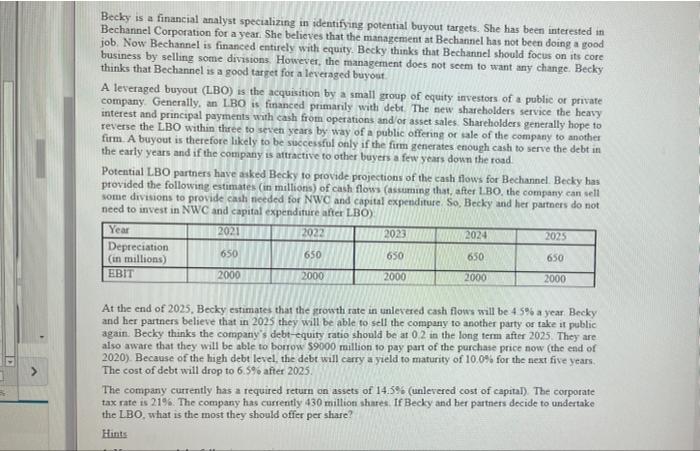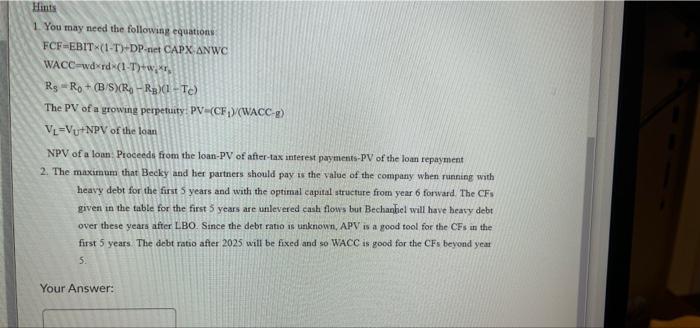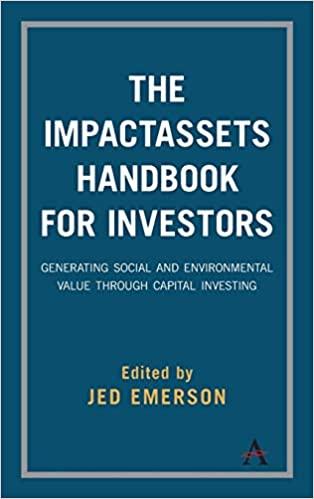1 Becky is a financial analyst specializing in identifying potential buyout targets. She has been interested in Bechannel Corporation for a year. She believes that the management at Bechannel has not been doing a good job. Now Bechannel is financed entirely with equity. Becky thinks that Bechannel should focus on its core business by selling some divisions. However, the management does not seem to want any change. Becky thinks that Bechannel is a good target for a leveraged buyout A leveraged buyout (LBO) is the acquisition by a small group of equity investors of a public or private company. Generally, an LBO is financed primarily with debt. The new shareholders service the heavy interest and principal payments with cash from operations and/or asset sales. Shareholders generally hope to reverse the LBO within three to seven years by way of a public offering or sale of the company to another firm. A buyout is therefore likely to be successful only if the firm generates enough cash to serve the debt in the early years and if the company is attractive to other buyers a few years down the road. Potential LBO partners have asked Becky to provide projections of the cash flows for Bechannel. Becky has provided the following estimates (in millions) of cash flows (assuming that, after LBO, the company can sell some divisions to provide cash needed for NWC and capital expenditure. So, Becky and her partners do not need to invest in NWC and capital expenditure after LBO) Year 2021 2022 2023 2024 2025 650 650 650 650 650 Depreciation (in millions) EBIT 2000 2000 2000 2000 2000 At the end of 2025, Becky estimates that the growth rate in unlevered cash flows will be 4.5% a year. Becky and her partners believe that in 2025 they will be able to sell the company to another party or take it public again. Becky thinks the company's debt-equity ratio should be at 0.2 in the long term after 2025. They are also aware that they will be able to borrow $9000 million to pay part of the purchase price now (the end of 2020). Because of the high debt level, the debt will carry a yield to maturity of 10.0% for the next five years. The cost of debt will drop to 6.5% after 2025. The company currently has a required return on assets of 14.5% (unlevered cost of capital). The corporate tax rate is 21%. The company has currently 430 million shares. If Becky and her partners decide to undertake the LBO, what is the most they should offer per share? Hints Hints 1. You may need the following equations FCF EBIT (1-T)-DP-net CAPX ANWC WACC wdrd (1-7)+w,*r, Rg Ro+ (B/S)(Ra-RB)(1-Tc) The PV of a growing perpetuity: PV-(CF)/(WACC-g) VL-Vu+NPV of the loan NPV of a loan: Proceeds from the loan-PV of after-tax interest payments-PV of the loan repayment 2. The maximum that Becky and her partners should pay is the value of the company when running with heavy debt for the first 5 years and with the optimal capital structure from year 6 forward. The CFs given in the table for the first 5 years are unlevered cash flows but Bechanhel will have heavy debt. over these years after LBO. Since the debt ratio is unknown, APV is a good tool for the CFs in the first 5 years. The debt ratio after 2025 will be fixed and so WACC is good for the CFs beyond year 5. Your Answer: 1 Becky is a financial analyst specializing in identifying potential buyout targets. She has been interested in Bechannel Corporation for a year. She believes that the management at Bechannel has not been doing a good job. Now Bechannel is financed entirely with equity. Becky thinks that Bechannel should focus on its core business by selling some divisions. However, the management does not seem to want any change. Becky thinks that Bechannel is a good target for a leveraged buyout A leveraged buyout (LBO) is the acquisition by a small group of equity investors of a public or private company. Generally, an LBO is financed primarily with debt. The new shareholders service the heavy interest and principal payments with cash from operations and/or asset sales. Shareholders generally hope to reverse the LBO within three to seven years by way of a public offering or sale of the company to another firm. A buyout is therefore likely to be successful only if the firm generates enough cash to serve the debt in the early years and if the company is attractive to other buyers a few years down the road. Potential LBO partners have asked Becky to provide projections of the cash flows for Bechannel. Becky has provided the following estimates (in millions) of cash flows (assuming that, after LBO, the company can sell some divisions to provide cash needed for NWC and capital expenditure. So, Becky and her partners do not need to invest in NWC and capital expenditure after LBO) Year 2021 2022 2023 2024 2025 650 650 650 650 650 Depreciation (in millions) EBIT 2000 2000 2000 2000 2000 At the end of 2025, Becky estimates that the growth rate in unlevered cash flows will be 4.5% a year. Becky and her partners believe that in 2025 they will be able to sell the company to another party or take it public again. Becky thinks the company's debt-equity ratio should be at 0.2 in the long term after 2025. They are also aware that they will be able to borrow $9000 million to pay part of the purchase price now (the end of 2020). Because of the high debt level, the debt will carry a yield to maturity of 10.0% for the next five years. The cost of debt will drop to 6.5% after 2025. The company currently has a required return on assets of 14.5% (unlevered cost of capital). The corporate tax rate is 21%. The company has currently 430 million shares. If Becky and her partners decide to undertake the LBO, what is the most they should offer per share? Hints Hints 1. You may need the following equations FCF EBIT (1-T)-DP-net CAPX ANWC WACC wdrd (1-7)+w,*r, Rg Ro+ (B/S)(Ra-RB)(1-Tc) The PV of a growing perpetuity: PV-(CF)/(WACC-g) VL-Vu+NPV of the loan NPV of a loan: Proceeds from the loan-PV of after-tax interest payments-PV of the loan repayment 2. The maximum that Becky and her partners should pay is the value of the company when running with heavy debt for the first 5 years and with the optimal capital structure from year 6 forward. The CFs given in the table for the first 5 years are unlevered cash flows but Bechanhel will have heavy debt. over these years after LBO. Since the debt ratio is unknown, APV is a good tool for the CFs in the first 5 years. The debt ratio after 2025 will be fixed and so WACC is good for the CFs beyond year 5. Your








